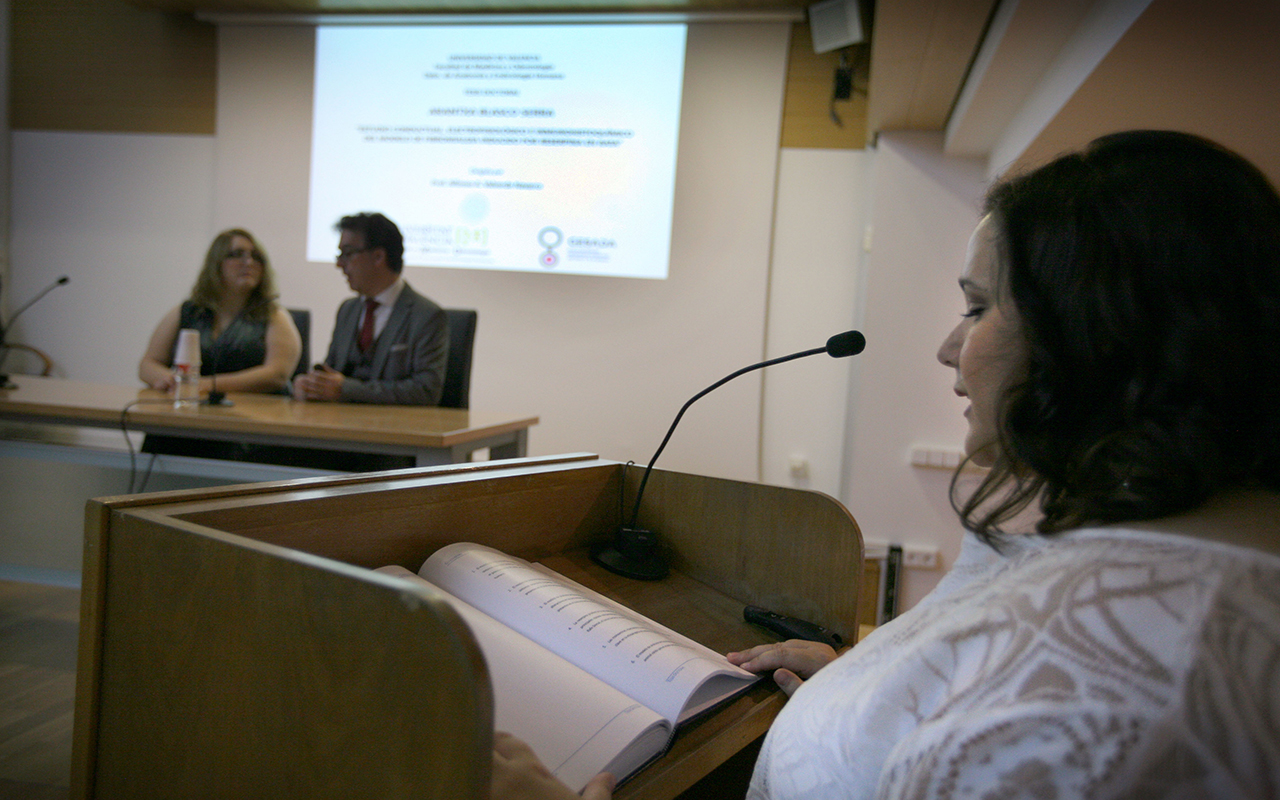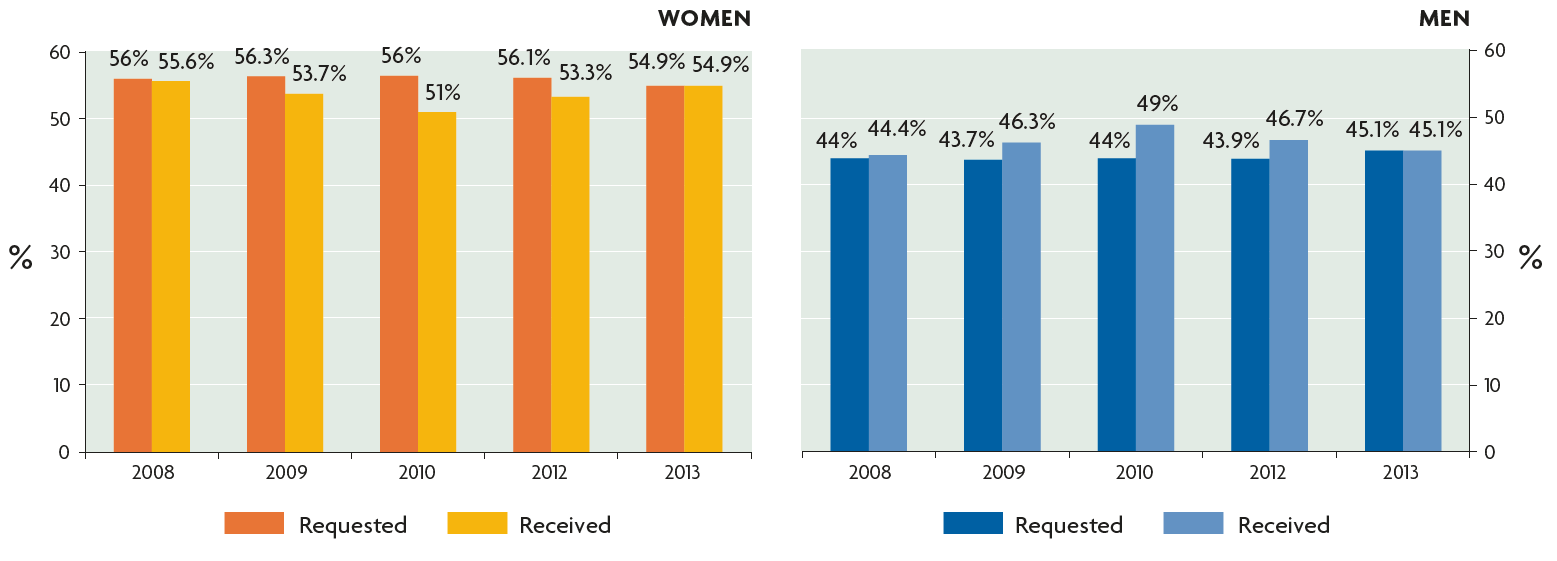Breaking the glass ceiling
The doctoral thesis defence as a key turning point

Statistics depict a university system that is not a space for equality – despite what we might expect of a meritocratic system. Women constitute a minority in positions of power and among high officials in university structures. This document analyses the possible causes in the decrease in women’s participation after defending their doctoral theses, a key moment that represents the start of the glass ceiling. It delves into the relationship between co-optation systems, male power networks, and the allocation of pre-doctoral grants.
Keywords: gender discrimination, glass ceiling, universities, higher education, PhD.
Taking an X-ray of the Spanish university system
The Spanish university system is characterised by feminisation. The statistics are conclusive. According to data from the Ministry of Education, Culture and Sport for the 2014/2015 school year, women formed the majority in undergraduate studies (54.9 %) and their average academic record was higher than men’s (7.38 and 7.05 respectively). Similarly, there were more women in official masters degrees (53.4 % of registrations and 53.2 % of graduations).
«There is one female full professor for every four men in the same position»
The tendency remains stable until the doctorate level, where the percentage of women starts to decrease (49.8 %). From that point on, the participation numbers for men and women in university activities are reversed. The number of women starts gradually decreasing, from the 53.2 % who obtain a master degree to the 49.2 % who pass their doctoral thesis (Ministerio de Educación, Cultura y Deporte, 2015).
This is commonly known as the «leaky pipeline», a term that refers to the «disproportionate flow of women who abandon the professional system in the field of science research and higher teaching» (De Pablo, 2006, p. 2). The defence of their doctoral thesis becomes a key turning point in the professional future of women who work in scientific and academic fields. At that moment, the glass ceiling looms over them.
«Women make up the majority of the university students at the beginning, but are progressively overtaken by their male colleagues, until they become an invisible minority in the highest levels of the system»
If we look at teaching and research personnel (PDIs, for its Spanish acronym) at Spanish universities, only 39.6 % of positions were occupied by women, mostly as professors and adjunct professors. This phenomenon, closely related to the glass ceiling, is known as the «sticky floor» (Torres & Pau, 2012) and refers to the existence of obstacles, also related to family and other care tasks, which female graduates must overcome in order to enter the first levels of academic careers. Metaphorically, it seems like women walk on ground that sticks to them and keeps them from advancing, and so they are over-represented in the lower part of the organisational pyramid. Female full professors represented 20.8 % of all full professors in Spanish public universities. So, we can say that there is one female full professor for every four men in the same position.
The data are reproduced in a «scissors» graph (Figure 1), where we observe a significant loss of female potential after the defence of their doctoral theses. Therefore, women make up the majority of the university students at the beginning, but are progressively overtaken by their male colleagues, until they become an invisible minority in the highest levels of the system. They go from a situation of equality among students, where the percentage of women is barely higher than the percentage of men, to an extraordinary imbalance in the number of women in the highest PDI positions: full professorships. Female full professors represent a symbolic minority within a male professional group that develops its work in an institution with, paradoxically, a predominance of women.

Figure 1. The distribution of men and women in academic careers in Spain during the year 2014/2015. Women represent the majority in the initial stages, but are gradually overtaken by their male colleagues. / Source: Nazareth Gallego-Morón. Data from the Spanish Ministry of Education, Culture and Sport.
Contrary to common assumptions, the situation has not changed substantially in recent years (Figure 2). During the 1996/1997 school year, 14.3 % of male academics were full professors, contrasting with only 5.2 % of women academics in the same position. Ten years later, during the 2006/2007 school year, these percentages were 14.8 % and 6 %, respectively. In the most recent year for which we have data, 2014/2015, a slight increase was recorded: female full professors increased to 6.5 % and their male counterparts increased to 15.5 %. However, the number of men remained almost triple that of women.

Figure 2. Percentage evolution of all teaching and research staff (PDI) to full professorships in Spain from the 1996/1997 school year to 2014/2015. In almost two decades the numbers have only changed slightly: the percentage of male full professors triples that of female counterparts. / Source: Nazareth Gallego-Morón. Data from the Spanish Ministry of Education, Culture and Sport.
In almost two decades, the percentage of women in PDI roles has increased by only 1.3 %. Paradoxically, at the same time, the number of men has continued to increase, specifically, by 1.2 %. Therefore, the slow increase in the number of female PDIs and scientists does not correspond to the overall increase in female graduates and PhD students.
«Inequality manifests itself more obviously among elected officials – such as the principal, deans, and school management – than in freely-designated positions»
Considering the presence of women in positions of responsibility for the administration of public universities, the situation is not much more encouraging. As for academic careers, the majority of positions related to the university administration and representation, as well as responsibility and decision-making positions, are held by men. In addition, inequality manifests itself more obviously among elected officials – such as the principal, deans, and school management – than in freely-designated positions.
Figure 3 shows how, in 2015, women represented only 2 % of the principals and 38.3 % of vice-principals among all the principal offices at public universities; equality was only found in general secretaries (52 % of women versus 48 % of men). However, in the case of managerial positions, despite being free-designation positions, just as for secretariats, the difference in the number of women and men was the second highest: the percentage of male managers was triple that of their female counterparts (76 % and 24 %, respectively).

Figure 3. Distribution of men and women in the team in the university principal’s office at a total of fifty Spanish public universities during the 2014/2015 school year. The most pronounced inequality is observed in the position of principal: only 2 % of women fill this office versus 98 % of men. / Source: Nazareth Gallego-Morón. Data from the Spanish Ministry of Education, Culture and Sport.
The glass ceiling at universities
Given the previously described statistical data, the existence of a glass ceiling in academia is evident. This same glass ceiling exists in every occupational area. However, numerous studies have shown that the faculty has low awareness of the problem (Alonso, 2002; García de León & García de Cortázar, 2001; Guil, Solano, & Álvarez, 2005). Both men and women often deny the existence of discrimination at universities and this situation is mostly rendered invisible by younger or less senior faculty members who perceive the problem with less intensity (Matus & Gallego, 2015).
The concept of the glass ceiling started to become commonly used in the 80s; it referred to an invisible, enclosed, and solid barrier (Morrison, White, & Van Velsor, 1987) that prevents women from being promoted to the highest positions in the pyramidal structure of employment organisations. However, the term is more complex: firstly, the obstacle might be solid and almost impassable, but it is still permeable. It is made of glass, and can be broken. Indeed, figures show that this is happening at the moment. Nevertheless, in order to do that, women must show significantly better results than their male peers and, in many cases, adopt roles that differ from those assumed by women who are not promoted. Secondly, it is not a single blocked, fenced, and easily-identifiable path, but rather, consists of several paths, many of which do not lead to the top, and thus is sometimes called the «glass labyrinth» (Ballarín, 2005). Finally, it is not a single barrier, but instead comprises a number of accumulating difficulties, which connects with the concept of sticky floors, referring to how difficult it is to move up from lower-ranking positions (Torres & Pau, 2012).
«Both men and women often deny the existence of discrimination at universities»
The literature regarding gender discrimination in employment is extensive. Many authors are concerned with the under-representation of women at the highest levels of the organisational pyramid, and so several studies and research projects have provided information which is very relevant to this matter. Despite this, the topic is only very rarely exclusively addressed in depth, and literature specifically related to this area in high-impact publications in Spain is scant (Matus & Gallego, 2015). However, Spanish studies have had an extensive and reputable trajectory.
«Empirical research is needed to resolve the causes of the glass ceiling and the obstacles it causes in academia»
Most literature is devoted to describing and measuring the phenomenon; nonetheless, as many authors confirm, empirical research is needed to resolve the causes of the glass ceiling and the obstacles it causes in academia, beyond the analysis of statistical data. Only in-depth understanding and analysis of the situation can allow us to design and intervene with policies to remove situations of inequality between the sexes.
The conclusions presented by those who analysed and detected the barriers and obstacles of the glass ceiling in academia are diverse, as are their suggested classifications. There is no consensus regarding the main causes of the phenomenon. However, Guil et al.’s (2005) suggestions, published in a research project elaborated for the entire Andalusian university system, are among the most complete classifications of the glass ceiling barriers yet; it distinguishes between personal barriers, organisational barriers, and those depending on social context. On the other hand, one of the most recurring classifications found in the literature is that posed by Tomás and Guillamón (2009). They analysed the barriers and obstacles faced by female professors on their way to university management positions in four Catalan universities, and separated them into internal and external barriers. The obstacles or problems mentioned are both numerous and diverse: below we present a synthesis of those most commonly mentioned in the literature.

The doctoral thesis defence emerges as the key moment at which the glass ceiling is imposed over women with professional aspirations in the field of research. The figures provide evidence for how this invisible barrier starts to fracture, but in order to break it women must show significantly better results than their male colleagues. / Jesús Císcar
Firstly, among the traditionally-observed obstacles, there is the balance between family, work, and personal life (Martínez, Serrano, Díaz, & López, 2011; Pastor, Belzunegui, Moreno, & Mañas, 2010; Simelio & Rovetto, 2008; Tomás & Guillamón, 2009) and difficulties derived from maternity and family responsibilities (Pastor et al., 2010). Secondly, other internal factors at the cognitive and emotional level, resulting from differences in male and female socialisation, are pointed out; these include fear of being evaluated, lack of trust in their own capabilities (Martínez et al., 2011), and self-image and self-esteem issues (Guil et al., 2005). Finally, studies and investigations coincide in the existence of a number of male power relations which are controlled by men (Alonso, 2002; García de León & García de Cortázar, 2001; Guil et al., 2005; Tomás & Guillamón, 2009). Thus, there is a relationship between male power and the occupation of high-level positions at the university, mainly full professorships, by men.
The lack of support for female doctoral candidates
The title of «doctor» represents the highest possible level in the current university system, which formally proves research ability within a scientific area. Taking into account that the key point at which the glass ceiling starts in academic careers is at the thesis defence, we must ask ourselves about the possible reasons behind the decision of female PhD candidates to abandon their career more than frequently than their male colleagues.
The literature has stated the existence of co-optation systems in universities. Given that they are expected to represent a space of equality, meritocratic systems are ineffective in this area, which puts their objectivity into question. Sánchez, De la Rica, and Dolado (2011, p. 12) stated that in 2011, the probability of a male university professor being promoted to full professor was 2.5 times higher than a woman’s in a similar family, work, and personal situation. This confirms the existence of a gender bias in the evaluation of scientific merit.
Moreover, we are social beings, we live and socialise in groups and this situation is reproduced in academia. Professors and researchers of both sexes consider the ability for social relations to be the main positive factor in university promotions (Alonso, 2002). Thus, belonging to a group becomes fundamental in order to get promoted in university careers.
«Given that they are expected to represent a space of equality, meritocratic systems are ineffective in this area, which puts their objectivity into question»
This poses the following question. Does this situation of discrimination constitute one of the main causes of the decline in women’s presence on university academic staff after the defence of their doctoral thesis? In 1997, Wennerás and Wold analysed the evaluation and distribution of postdoctoral grants in Sweden. They concluded that the lack of women’s success at universities could not be explained by their scientific or academic productivity and showed that the peer-review processes failed to judge scientific merit independently from sex and that women had to be 2.5 times more productive than the average male applicant in order to receive a similar rating. The lack of support and funding for women comes from the setting of nepotism and co-optation (Simelio & Rovetto, 2008) which are both considered to have a fundamental role in young women’s professional academic careers.
It is well known that completing a PhD involves a lot of dedication, resources, and support, together with a strong ability to form social relationships. Hence, together, the research described above indicates that there is a relationship between the economic resources of universities and their productivity. Therefore, being well positioned within the university structure, i.e., having sufficient contacts and support within university departments, becomes imperative. If we take into account the existence of co-optation systems, obtaining a pre-doctoral contract and being promoted can become «a matter of being well positioned within power circles» (Alonso, 2002, p. 6).
The university faculty training programme
The results from the call for University Faculty Training Programme (FPU, for its Spanish acronym) grants, which provide helpful teaching and research training, have been collected and analysed over the last three years as part of the National Plan for Scientific, Technical, and Innovation Research 2013-2016 (BOE, dated 7 September 2013). This training has become essential for teaching and research staff in the Spanish university system, as corroborated by indicators that show its role in the training of new professionals, innovation, knowledge transfer and dissemination of scientific and humanistic culture.
As evidenced in the latest FPU grants resolution for 2015 (19 November), the evaluation system combines applicants’ merits with those of their training-process mentors for these types of competitive calls, including their doctoral thesis director and the teaching and research team where the applicant will be included.
Regarding FPU awards, the percentage of grants given to women compared to men was lower than the percentage of grant applications by female pre-doctoral students (Figure 4). With the exception of the last call for which we have official data, in 2013 (where the percentage of total applications matched the total number of awards given to women), the percentage of women awarded a grant was lower than the percentage applying for them in all the previous calls. This was most notable in 2010 as shown by a 5-percentage-point difference in the awards granted to women compared to those applying for them (56 % of applications and 51 % of concessions).

Figure 4. Comparison between the percentage of FPU grants requested and received, disaggregated by sex, between 2008 and 2013. The graph shows that the percentage of grants received by men is usually higher than the percentage of grants requested by men. This translates into a higher success ratio for male PhD candidates, who, despite being in the minority of applicants for these grants, have a better chance of becoming their beneficiaries. / Source: Nazareth Gallego-Morón. Data from the Spanish Ministry of Education, Culture and Sport.
It is also of note that the fraction of applications by women has declined over time. Thus, in 2008, applications by women constituted 56 % of the total, but five years later, they had decreased by more than 1 percentage point, to 54.9 %. Considering differences by gender, the percentage of male applicants was lower than that of female applicants in every call; in 2009 it was 12.6 % but in 2009 it had reduced to 9.8 %. However, in contrast to female PhD candidates, the percentage of male beneficiaries was always higher than their respective grant-solicitation rate.
Despite the fact that the percentage of female recipients is higher than that of men, their success ratio is lower than that of their male colleagues. In other words, with the exception of the 2013 call, the success ratio for women is lower than 1 (where 1 corresponds to an equal percentage rate of grant awards to applications), whereas the success ratio for men always reaches 1 (2008 and 2013 calls) or even surpasses it, having reached a ratio of 1.11 in the 2010 call.
Conclusions
Taking into account that women in academia are the majority both in quantity and quality, the above analysis highlights a gender bias in how academic merit is evaluated. On the one hand, there are more female PhD candidates, and on the other, the statistics show that, on average, their academic records are better than that of their male counterparts.
«Both the university and grant-award systems are intended to be based on a meritocracy, and so it is absolutely essential that we continue to develop empirical tests to check for gender bias in merit evaluation»
In the example of FPU grant evaluations, the career-path of both the potential research team and doctoral thesis director are also considered. This means that casual male power systems and existing co-optation practises might affect the process, providing relatively more support to men starting to develop their academic career compared to women. Thus, recognition that these power mechanisms exist and understanding how they work has become an essential task in the design of intervention policies and strategies against gender discrimination. Further investigation into this matter would require access to historical data, allowing all grant applications and results to be analysed; however, this is not easy because access to this type of data is limited and its analysis requires substantial dedication and time.
Both the university and grant-award systems are intended to be based on a meritocracy, and so it is absolutely essential that we continue to develop empirical tests to check for gender bias in merit evaluation, especially regarding the quality of the curricula of applicants and their doctoral thesis directors, in order to understand and explain the lower success rate of female PhD candidates who apply for FPU grants.
REFERENCES
Alonso, M. J. (2002). Las académicas. Profesorado universitario y género. Revista de Educación, 328, 465–475.
Ballarín, P. (2005). Mujeres en el «laberinto de cristal» universitario. In I. de Torres Ramírez (Coord.), Miradas desde la perspectiva de género: Estudios de las mujeres (pp. 183–194). Madrid: Narcea.
De Pablo, F. (2006). Científicas y tecnólogas: Especies a proteger. In C. Lara (Ed.), El segundo escalón: Desequilibrios de género en ciencia y tecnología. Sevilla: ArCiBel. Retrieved from http://www.amit-es.org/assets/files/publi/fdepablo_06.pdf
García de León, M. A., & García de Cortázar, M. L. (Coord.). (2001). Las académicas. Profesorado universitario y género. Madrid: Instituto de la Mujer.
Guil, A., Solano, A., & Álvarez, M. (2005). La situación de las mujeres en las universidades públicas andaluzas. Sevilla: Consejo Económico y Social de Andalucía.
Martínez, M. R., Serrano, M. A., Díaz, M. C., & López, J. M. (2011). Identificación de las principales dificultades que obstaculizan el acceso a los órganos de gobierno en las universidades españolas. In I. Vázquez Bermúdez (Coord.), Logros y retos: Actas del III Congreso Universitario Nacional «Investigación y género» (pp. 1239–1257). Sevilla: Unidad para la Igualdad, Universidad de Sevilla.
Matus, M., & Gallego, N. (2015). Techo de cristal en la universidad. Si no lo veo no lo creo. Revista Complutense de Educación, 26(3), 611–626. doi: 10.5209/rev_rced.2015.v26.n3.44491
Ministerio de Educación, Cultura y Deporte. (2015). Datos y cifras del sistema universitario español. Curso 2014-2015. Madrid: Ministerio de Educación, Cultura y Deporte.
Morrison, A. M., White, R. P., & Van Velsor, E. (1987). Breaking the glass ceiling: Can women reach the top of America’s largest corporations? New York, NY: Addison-Wesley.
Pastor, I., Belzunegui, A., Moreno, B., & Mañas, C. (2010). La igualtat d’oportunitats a la universitat: Les percepcions del PDI. Papers: Revista de Sociologia, 95(2), 457–481. doi: 10.5565/rev/papers/v95n2.19
Resolución de 19 de noviembre de la Secretaría de Estado de Educación, Formación Profesional y Universidades por la que se convocan ayudas para la formación de profesorado universitario. (2015). Retrieved from https://www.boe.es/boe/dias/2015/11/27/pdfs/BOE-A-2015-12849.pdf
Sánchez, I., De la Rica, S., & Dolado, J. J. (Coord.). (2011). Libro blanco: Situación de las mujeres en la ciencia en España. Madrid: Ministerio de Ciencia e Innovación.
Simelio, N., & Rovetto, F. (2008). La situación de las profesoras jóvenes en la Facultad de Ciencias de la Comunicación de la UAB. Zer-Revista de Estudios de Comunicación, 13(25), 287–307.
Tomás, M., & Guillamón, C. (2009). Las barreras y los obstáculos en el acceso de las profesoras universitarias a los cargos de gestión académica. Revista de Educación, 350, 253–275.
Torres, O., & Pau, B. (2012). «Techo de cristal» y «suelo pegajoso»: La situación de la mujer en los sistemas alemán y español de ciencia y tecnología. CTS: Revista Iberoamericana de Ciencia, Tecnología y Sociedad, 6(18), 35–59.
Wennerás, C., & Wold, A. (1997). Nepotism and sexism in peer-review. Nature, 387(6631), 341–343. doi: 10.1038/387341a0





